The Beginner’s Guide: Screwball Comedy
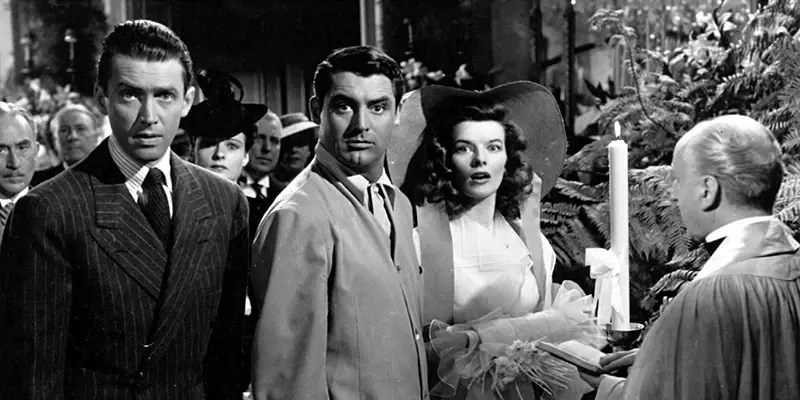
Amanda Mazzillo is a writer with an MFA in Dramatic…
Screwball comedies came around in the 1930s, due to the Motion Picture Production Code. The genre is still popular today, and some filmmakers try to recreate the themes and techniques in modern films.
By 1934, the production code was being enforced in the motion picture industry. The code was accepted partially as a way to hold off direct government censorship. By using a self-censorship technique, the motion picture industry was able to keep some control on what could and could not be done in film. This list of regulations caused filmmakers to reevaluate how they tell stories. The Screwball Comedy was born from a need to tell stories without going against these new rules of censorship.
A Brief History of the Screwball Comedy
It is seen as primarily an American film genre because it came from American censorship and only lasted as long as the code. The code started to weaken in the 1950s due to foreign films which did not have the same regulations, and filmmakers tried harder and harder to push the envelope of what they could do and say in their films.
The Screwball Comedy genre came from censorship, but the films seem to unlock a different type of creative expression, one that may not have come about without this original restriction. These films had to rely on innuendo and banter between the leads as a replacement for physical displays of sexual tension.
Screwball Comedy films also include a variety of other features including: witty, fast-paced dialogue, misunderstandings, the battle of the sexes, and the struggle between different social classes. They tend to end in happy endings, which may seem undeserved to a fan of films where the romance is taken seriously, but these paint the picture of a traditional screwball comedy.
At the end of the screwball comedy, you might ask yourself: are these two going to divorce again by next week? The answer may be yes, but we still adore their love stories and hope for the best.
Ten Screwball Comedies to Check Out
These ten films are important examples of films from the screwball era of American cinema. These films will work as a great introduction to the genre, and will hopefully inspire more people to appreciate and explore it.
It Happened One Night (1934, Frank Capra)
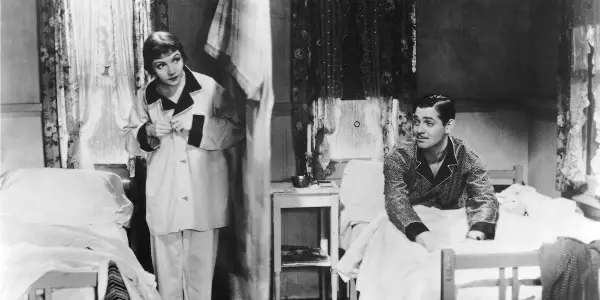
It Happened One Night (1934) is an early screwball comedy, which is well regarded and remembered within the genre. The film focuses on a relationship between characters of very different social classes. Ellie (Claudette Colbert) is an heiress who wants to reunite with her spouse, and Peter (Clark Gable) is a recently fired newspaper reporter. They are both on a bus to New York City. Initially, the two characters have a considerable amount of disdain for one another, but as the film continues and they become more intertwined, they fall in love.
This film involves the characters sleeping in the same room, which was not accepted by the production code. To go around this, a scene is dedicated to putting up a divider between their beds. This shows how the films in this era could still get away with more sexual content by coyly playing with the guidelines of the code.
The Thin Man (1934, W.S. Van Dyke)
The Thin Man (1934) might not have all the features of the typical screwball comedy, but the essence of the genre is present here. The film might not be focused on a budding romance, but the banter still plays quick and strong between characters of differing social classes. Nick (William Powell) and Nora Charles (Myrna Loy) play wonderfully off each other in this detective comedy.
The effortlessly witty dialogue here perfectly captures the tone of the genre. This film also shows the screwball staple of societal differences, by having Nick mention to Nora that he married her for her money. Another screwball trope involves the woman being in charge, which is true here as well.
My Man Godfrey (1936, Gregory La Cava)
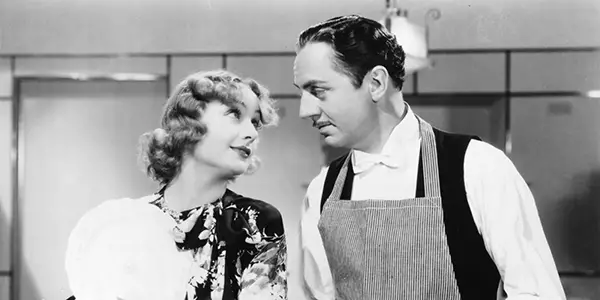
My Man Godfrey (1936) follows a rich, eccentric family, including a scatter-brained daughter, Irene (Carole Lombard), who falls for Godfrey (William Powell), a down-and-out man found at a hobo colony. He is used for a scavenger hunt, but eventually ends up hired as a butler. This film is pure screwball goodness, with commentary on social classes in the 1930s and banter between its characters.
This is a wonderful example of the female character leading the man on adventures they would not have experienced without her. The film is fun and paints a clear picture of the societal differences at the time.
Nothing Sacred (1937, William A. Wellman)
Nothing Sacred (1937) is one of the only Technicolor screwball comedies. It follows Hazel (Carole Lombard) and Wally (Fredric March) as they fall in love in a strange way, typical of the screwball comedy. Hazel is a young woman who is dying from radium poisoning. Wally is a newspaper reporter, chosen to interview Hazel as a way to bring more attention to his newspaper.
Throughout the film, Hazel discovers she is not dying, but keeps this a secret as she becomes an inspiration. She is seen as an inspiration because she wants to live her life fully in the short time she has left. The film is well-regarded in the screwball genre, because it shows the greed in the newspaper industry, by showing how far they will go to obtain a story.
The marketing of the film played up a boxing scene between Hazel and Wally, which fits in with the screwball comedy trope of passionate hatred becoming love over time.
Bringing Up Baby (1938, Howard Hawks)
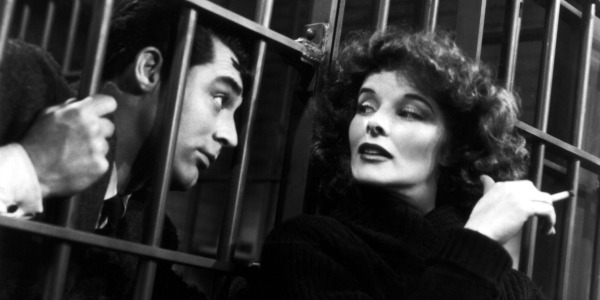
Bringing Up Baby (1938) pairs up Katharine Hepburn and Cary Grant in a delightful screwball romp directed by Howard Hawks, who is a premiere director in this genre. The film focuses on Susan Vance and Dr. David Huxley. In typical screwball fashion, these characters are the opposite of one another. David is a mild-mannered paleontologist, while Susan is a rather free-spirited woman.
The plot is quintessential screwball, with all its twists and turns and mistaken identities. A large part of this film revolves around people not entirely knowing who they are dealing with. These instances of mistaken identities are a common feature in screwball comedies, which work to create the twisty and amusing plots.
Romance is second to comedy in Bringing Up Baby. It is not shown as something serious or melodramatic, which is one of the defining factors separating screwball comedy from romantic comedy. This is an essential film to watch if you wish to explore all that the screwball comedy genre has to offer. From singing a soothing song to a leopard to searching for a dinosaur bone buried by a dog, this film has so much to offer a fan of the genre.
His Girl Friday (1940, Howard Hawks)
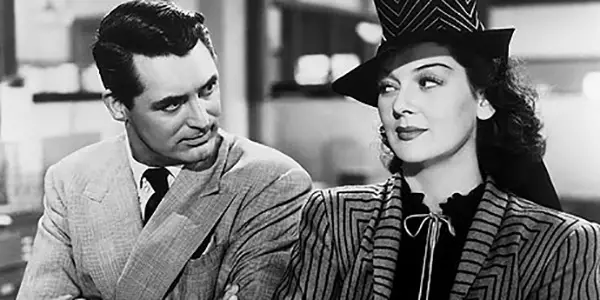
His Girl Friday (1940) is another Howard Hawks film. This time, it stars Cary Grant as Walter Burns and Rosalind Russell as Hildy Johnson. Walter and Hildy are a divorced couple, which is a common theme in screwball comedies. If a film wanted to show philandering spouses at the time of the production code, they had to be divorced, and a happy ending would result in the couple getting remarried before the credits rolled.
The dialogue in this film is so fast-paced, and the chemistry between the leads is electric, as they banter and argue themselves back together.
Another screwball staple represented in His Girl Friday is the threat of normalcy. In this film, Hildy is planning to remarry and settle down, leaving her reporter life behind. Either the man or woman leaving behind something that defines their personality is common in the genre. It normally ends tied up nicely, with the lead characters meeting, going on an adventure, and choosing to end up together instead of settling for their previous love interest. Instead of marrying the bland insurance man, Hildy ends up back with her ex-husband, who knows and appreciates her as a reporter and does not want her to leave her career for a life in the suburbs.
The Philadelphia Story (1940, George Cukor)
The Philadelphia Story (1940) blends elements of screwball and romantic comedy into a compelling story of remarriage and social class. The story focuses on the socialite Tracy (Katharine Hepburn), her ex-husband Dexter (Cary Grant), and reporter Mike (Jimmy Stewart) as they are all awaiting Tracy’s marriage, with the hope of covering the story.
This film flits between screwball comedy and romantic comedy, as the romance is taken more seriously than in typical screwball comedies. The plot features many screwball elements including remarriage, social class, and love triangles. This film ends the same way as many screwball comedies, with remarriage. The divorced couple begin to show interest in other people, but ultimately realize they are meant to be together.
The main action of this film comes from a unique circumstance where many people, who may not normally spend time together, are forced to co-exist. This creates a blending of social classes and personalities, which is the cause for most of the comedy of the film. Characters do things they might never have done before, an example being Tracy getting drunk for only the second time in her life.
The Lady Eve (1941, Preston Sturges)
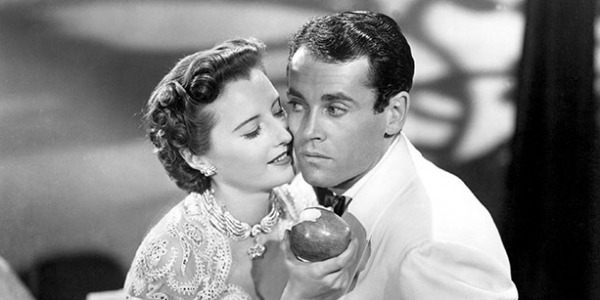
The Lady Eve (1941) follows a con artist, Jean Harrington, played by Barbara Stanwyck, and a rich, naive heir to the Pike Ale fortune, Charles Pike, portrayed by Henry Fonda. This flips the roles from other screwball comedies, but the woman is still the one controlling the relationship. In several other screwball comedies, the woman is rich and the man is a bumbling everyman. This does flip the social differences, but remains with the woman being the mastermind and the reason for change.
Charles is naive to women, who have suddenly taken interest in him, which Jean uses to her advantage in the form of a con. The romance comes when Jean falls for her mark, and tries to protect him from her father, ruining the con they had set out to complete.
The film falls even more into the screwball territory once Jean masquerades as Lady Eve Sidwich, in another con of sorts. The film keeps twisting and turning towards a happy ending, like any good screwball comedy.
The Major & The Minor (1942, Bill Wilder)
The Major and the Minor (1942) is the directorial debut of Billy Wilder. This film follows the screwball comedy setup of a woman changing the life of a man through a case of mistaken identity. Ginger Rogers portrays Susan Applegate, a woman pretending to be a 12-year-old kid, in order to get a cheaper train fare. During her adventure she meets Major Kirby, portrayed by Ray Milland.
The Major and the Minor might not be a film everyone thinks about when they think of the screwball comedy, but so many of the elements that help make the genre exist within it. The plot revolves around mistaken identity and the woman is responsible for a change in the male. This film is a nice mix of zany and endearing.
The comedy in this film revolves around the deliberate deception of identity surrounding Susan. She meets others around the age she is pretending to be, and these are the only characters who have the faintest idea that she isn’t who she says she is. The adult characters in the film all easily believe it, more so than the audience. Some of the comedy comes from this disconnect between what the audience sees as a poor disguise and the ease in which the other characters believe the facade.
Ball of Fire (1941, Howard Hawks)
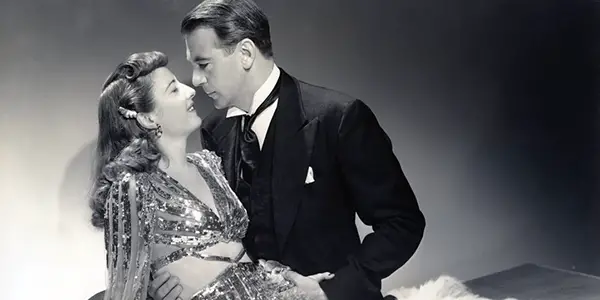
Ball of Fire (1941) follows a secluded professor, Bertram Potts (Gary Cooper), as he travels out into the world and meets “Sugarpuss” O’Shea (Barbara Stanwyck), and becomes enamored by her use of American slang. This film drives from the differences between the characters. Bertram and his professor friends all live together, putting together an encyclopedia on human knowledge, but realizing they are cut off from society and cannot accurately discuss current slang.
Bertram meets Sugarpuss while he is conducting research for this encyclopedia, at a nightclub where she is performing. This outing to see real people in the real world ends up taking Bertram and his professor friends on an adventure, helping Sugarpuss avoid the police and escape from her mobster boyfriend.
Throughout their interactions, Sugarpuss and Bertram grow close, even though she was reluctant at first. Sugarpuss ends up changing Bertram’s life by taking him on an adventure he would never have experienced without her. She makes him truly see the people he has spent his life writing about.
Conclusion
All of these films display features of the traditional screwball comedy, from divorce and remarriage to mistaken identities and suppressed societal differences. These films work well in telling these passionate, hilarious stories we have come to love and appreciate as quintessential American cinema.
The Motion Picture Production Code influenced how comedies were made in the 1930s and 1940s, which gave us a genre we may never see in this exact way again. The screwball comedy was a reflection of a specific time and place, which might not be replicated honestly in motion pictures.
A few times, though, people have tried to create modern representations of screwball comedies. Some examples include: Mistress America, She’s Funny That Way, Overboard, Flirting with Disaster, Intolerable Cruelty, and What’s Up Doc?
Do you think the Motion Picture Production Code prevented or helped creativity in the comedies of the 1930s and early 1940s? What screwball comedies are your favorites and which modern films do you think best emulate the elements of the genre? Please share your thoughts in the comments.
Does content like this matter to you?
Become a Member and support film journalism. Unlock access to all of Film Inquiry`s great articles. Join a community of like-minded readers who are passionate about cinema - get access to our private members Network, give back to independent filmmakers, and more.
Amanda Mazzillo is a writer with an MFA in Dramatic Writing from SCAD and a BA in Writing & Linguistics and Film Studies minor from Georgia Southern University. She enjoys writing comedy and exploring all forms of media. Her Twitter name is a bad pun: @mazzillofirefox













